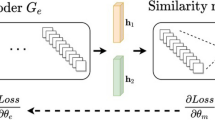Abstract
A method based on the theory of deep learning and feature extraction and a fault diagnosis model of a rolling bearing based on deep belief network are proposed in this study considering the complex, nonlinear, and non-stationary vibration signal of the rolling bearing. To some extent, the method avoids the complex structure of deep neural network and can be easily trained. Experimental results show that the recognition rate of the method reaches 100 %. The method can identify various types of faults accurately and has good fault diagnosis capability, which can provide the convenience for maintenance.
Similar content being viewed by others
References
M. F. Paul, Fault diagnosis in dynamic systems using analytical and knowledge–based redundancy, A survey and some new results, Automatica, 26 (3) (1990) 459–474.
Y. Lei et al., A deep learning–based method for machinery health monitoring with big data, Journal of Mechanical Engineering, 51 (9) (2015) 49–56.
L. Guo, H. L. Gao and Y. W. Zhang, Research on bearing condition monitoring based on deep learning, Journal of Vibration & Shock, 12 (2016) 166–170.
S. Zhang, Bearing condition dynamic monitoring based on Multi–way sparse autocoder, Journal of Vibration & Shock, 35 (19) (2016) 125–131.
Z. J. Sun et al., Overview of deep learning, Application Research of Computers, 8 (2012) 2806–2810.
E. Assareh et al., Optimizing the wind power generation in low wind speed areas using an advanced hybrid RBF neural network coupled with the HGA–GSA optimization method, Journal of Mechanical Science & Technology, 30 (10) (2016) 4735–4745.
V. T. Tran, F. Althobiani and A. Ball, An approach to fault diagnosis of reciprocating compressor valves using Teager–Kaiser energy operator and deep belief networks, Expert Systems with Applications, 41 (9) (2014) 4113–4122.
J. Mi, Ya. Y. F. Li, W. Peng and H. Z. Huang, Reliability analysis of complex multi–state system with common cause failure based on evidential networks, Reliability Engineering & System Safety, 174 (2018) 71–81.
I. A. Khan and D. R. Parhi, Fault detection of composite beam by using the modal parameters and RBFNN technique, Journal of Mechanical Science & Technology, 29 (4) (2015) 1637–1648.
T. Prasanna and P. F. Wang, Failure diagnosis using deep belief learning based health state classification, Reliability Engineering and System Safety, 115 (2013) 124–135.
M. Yakout, A. Elkhatib and M. G. A. Nassef, Rolling element bearings absolute life prediction using modal analysis, Journal of Mechanical Science & Technology, 32 (1) (2018) 91–99.
H. Yuan, J. Chen and G. Dong, An improved initialization method of D–KSVD algorithm for bearing fault diagnosis, Journal of Mechanical Science & Technology, 31 (11) (2017) 5161–5172.
W. Zhang et al., Weighted sparsity–based denoising for extracting incipient fault in rolling bearing, Journal of Mechanical Science & Technology, 31 (10) (2017) 4557–4567.
J. Zhang et al., Realizing the empirical mode decomposition by the adaptive stochastic resonance in a new periodical model and its application in bearing fault diagnosis, Journal of Mechanical Science & Technology, 31 (10) (2017) 4599–4610.
Author information
Authors and Affiliations
Corresponding author
Additional information
This paper was presented at ICMR 2017 & QR2MSE 2017, Crowne Plaza Chengdu West, Chengdu, China, October 24–27, 2017. Recommended by Guest Editor Dong Ho Bae.
Zhiwu Shang is a Professor at the School of Mechanical Engineering at Tianjin Polytecnic University of China. He received his Ph.D. degree in Mechanical Engineering from Tianjin University, China. He has published 50 journal papers in fields of fault diagnosis and product development.
Xiangxiang Liao is currently a master’s candidate in Mechanical Engineering at Tianjin Polytecnic University of China. His research interests include fault diagnosis and product development.
Rui Geng is currently a master’s candidate in Mechanical Engineering at Tianjin Polytecnic University of China. His research interests include fault diagnosis and product development.
Maosheng Gao is currently a master’s candidate in Mechanical Engineering at Tianjin Polytecnic University of China. His research interests include fault diagnosis and product development.
Xia Liu is currently a master’s candidate in Mechanical Engineering at Tianjin Polytecnic University of China. Her research interests include fault diagnosis and product development.
Rights and permissions
About this article
Cite this article
Shang, Z., Liao, X., Geng, R. et al. Fault diagnosis method of rolling bearing based on deep belief network. J Mech Sci Technol 32, 5139–5145 (2018). https://doi.org/10.1007/s12206-018-1012-0
Received:
Revised:
Accepted:
Published:
Issue Date:
DOI: https://doi.org/10.1007/s12206-018-1012-0




